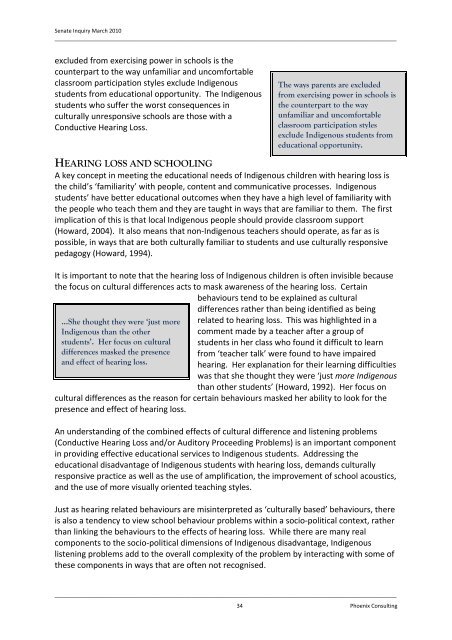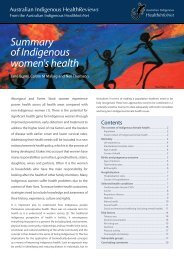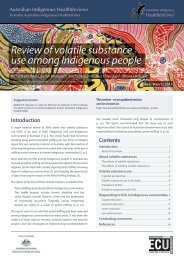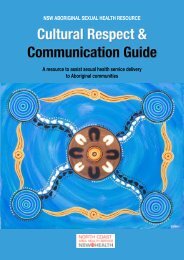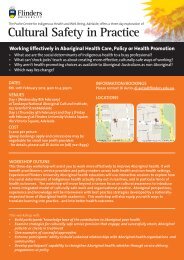hearing loss and the criminal justice system - Australian Indigenous ...
hearing loss and the criminal justice system - Australian Indigenous ...
hearing loss and the criminal justice system - Australian Indigenous ...
You also want an ePaper? Increase the reach of your titles
YUMPU automatically turns print PDFs into web optimized ePapers that Google loves.
Senate Inquiry March 2010_________________________________________________________________________________________________________________excluded from exercising power in schools is <strong>the</strong>counterpart to <strong>the</strong> way unfamiliar <strong>and</strong> uncomfortableclassroom participation styles exclude <strong>Indigenous</strong>students from educational opportunity. The <strong>Indigenous</strong>students who suffer <strong>the</strong> worst consequences inculturally unresponsive schools are those with aConductive Hearing Loss.The ways parents are excludedfrom exercising power in schools is<strong>the</strong> counterpart to <strong>the</strong> wayunfamiliar <strong>and</strong> uncomfortableclassroom participation stylesexclude <strong>Indigenous</strong> students fromeducational opportunity.HEARING LOSS AND SCHOOLINGA key concept in meeting <strong>the</strong> educational needs of <strong>Indigenous</strong> children with <strong>hearing</strong> <strong>loss</strong> is<strong>the</strong> child’s ‘familiarity’ with people, content <strong>and</strong> communicative processes. <strong>Indigenous</strong>students’ have better educational outcomes when <strong>the</strong>y have a high level of familiarity with<strong>the</strong> people who teach <strong>the</strong>m <strong>and</strong> <strong>the</strong>y are taught in ways that are familiar to <strong>the</strong>m. The firstimplication of this is that local <strong>Indigenous</strong> people should provide classroom support(Howard, 2004). It also means that non‐<strong>Indigenous</strong> teachers should operate, as far as ispossible, in ways that are both culturally familiar to students <strong>and</strong> use culturally responsivepedagogy (Howard, 1994).It is important to note that <strong>the</strong> <strong>hearing</strong> <strong>loss</strong> of <strong>Indigenous</strong> children is often invisible because<strong>the</strong> focus on cultural differences acts to mask awareness of <strong>the</strong> <strong>hearing</strong> <strong>loss</strong>. Certainbehaviours tend to be explained as culturaldifferences ra<strong>the</strong>r than being identified as being…She thought <strong>the</strong>y were ‘just more<strong>Indigenous</strong> than <strong>the</strong> o<strong>the</strong>rstudents’. Her focus on culturaldifferences masked <strong>the</strong> presence<strong>and</strong> effect of <strong>hearing</strong> <strong>loss</strong>.related to <strong>hearing</strong> <strong>loss</strong>. This was highlighted in acomment made by a teacher after a group ofstudents in her class who found it difficult to learnfrom ‘teacher talk’ were found to have impaired<strong>hearing</strong>. Her explanation for <strong>the</strong>ir learning difficultieswas that she thought <strong>the</strong>y were ‘just more <strong>Indigenous</strong>than o<strong>the</strong>r students’ (Howard, 1992). Her focus oncultural differences as <strong>the</strong> reason for certain behaviours masked her ability to look for <strong>the</strong>presence <strong>and</strong> effect of <strong>hearing</strong> <strong>loss</strong>.An underst<strong>and</strong>ing of <strong>the</strong> combined effects of cultural difference <strong>and</strong> listening problems(Conductive Hearing Loss <strong>and</strong>/or Auditory Proceeding Problems) is an important componentin providing effective educational services to <strong>Indigenous</strong> students. Addressing <strong>the</strong>educational disadvantage of <strong>Indigenous</strong> students with <strong>hearing</strong> <strong>loss</strong>, dem<strong>and</strong>s culturallyresponsive practice as well as <strong>the</strong> use of amplification, <strong>the</strong> improvement of school acoustics,<strong>and</strong> <strong>the</strong> use of more visually oriented teaching styles.Just as <strong>hearing</strong> related behaviours are misinterpreted as ‘culturally based’ behaviours, <strong>the</strong>reis also a tendency to view school behaviour problems within a socio‐political context, ra<strong>the</strong>rthan linking <strong>the</strong> behaviours to <strong>the</strong> effects of <strong>hearing</strong> <strong>loss</strong>. While <strong>the</strong>re are many realcomponents to <strong>the</strong> socio‐political dimensions of <strong>Indigenous</strong> disadvantage, <strong>Indigenous</strong>listening problems add to <strong>the</strong> overall complexity of <strong>the</strong> problem by interacting with some of<strong>the</strong>se components in ways that are often not recognised._________________________________________________________________________________________________________________34 Phoenix Consulting


